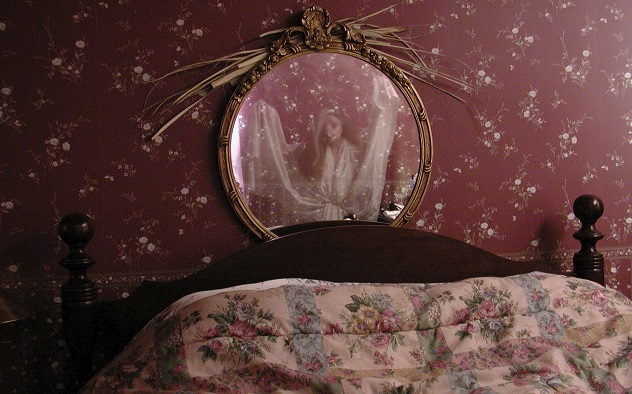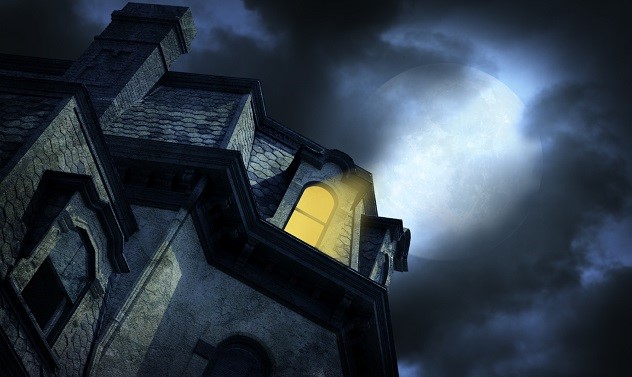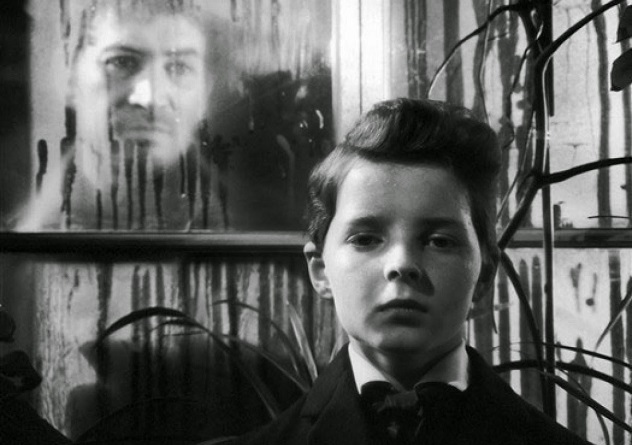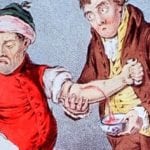10 ‘The Stalls Of Barchester’M.R. James
M.R. James is one of the most celebrated Victorian writers of the Christmas ghost story. A King’s College, Cambridge man, he spent most of his spare time cataloguing medieval manuscripts—a pastime that made itself heard in his stories. And his readings on Christmas Eve were something of an event, with new stories performed before a small, select audience in the dim firelight of the waning night. The tradition hasn’t been entirely lost thanks to the BBC series A Ghost Story for Christmas, which took James’s “The Stalls of Barchester” to the small screen. “The Stalls of Barchester” begins with an obituary—a seemingly normal obituary for a Dr. Haynes—until the narrator skips the cause of death and starts talking about his work cataloguing manuscripts for the university Dr. Haynes had belonged to. During his work, he finds a dusty set of papers sealed in a box. After realizing the papers belong to the deceased, he decides to take them home. In the middle of all the expected letters and journal pages, the narrator finds a story about the death of the archdeacon of Barchester Cathedral. The man had slipped and fallen down the stairs, and his maid was blamed for failing to replace a missing stair rod. Haynes was then made archdeacon, and he found that the cathedral’s daily affairs had been solely neglected for some time. In addition to implementing all the necessary reforms, Haynes also began looking into the origins of three strange carved figures in the archdeacon’s office: a cat, a royal-looking figure with horns and pointed ears, and a monk whose cord belt is held tightly by a hand concealed by carved drapes. He also found the wood for the carvings came from a copse of trees that included one called the Hanging Oak. As the story progresses, the writings in Haynes’s diaries get darker and more desperate. The narrator reveals that Haynes had begun dreaming that the carvings had a certain life. He’d started hearing voices, seeing shadowy, phantom cats in his home, and hearing strange knockings while he was alone. And then the narrator finds payments made to the maid who was expelled from the service of the previous archdeacon. Haynes’s guilt becomes clear, and we learn that the man met his demise in the same way as his predecessor, only with the addition of strange facial wounds indicating an animal attack. The narrator goes on to track down the carved figures now missing from the church. However, he can only find the remains of a single carving—a handwritten curse that had been concealed in one of the statues—claiming that anyone who touches it with bloody hands will pay the price.
9 Ghosts And Family Legends: A Volume For ChristmasCatherine Crowe
In 1858, Catherine Crowe set to paper a series of ghost stories told by friends and family the previous Christmas. Gathered around the fire and faced with some undisclosed, somber news, they’re challenged with the idea that there’s more to life than what we see in the day-to-day. They begin discussing not just the ghostly and paranormal, but family and loved ones as well, agreeing to tell a series of stories about how the supernatural has touched their lives. Miss P. begins on the first evening, talking about a man who’d once been her fiance. A military man, he was sent away to the West Indies, delaying their marriage. One evening during their separation, Miss P. lay down for a nap. Eventually, she was awoken by the appearance of her “Captain” at the door. He drew up a chair to sit beside her, and he spoke with her for around half an hour before looking at his watch and saying it was time to go. When her family came to comfort the now-hysterical Miss P., they found the chair sitting where his specter had supposedly left it. About a month later, Miss P. received news of her fiance’s death. He had died on the same day he’d visited her. Other stories continue to focus on the sometimes eerie spiritual connection that families share, a connection that is more relevant at Christmas than any other time of the year. Another partygoer tells the story of her maid, Rachel, who sees a specter of her sister only to find she’d died on the very same night. The storytelling goes on for eight evenings, with tales of ghostly cats and strange dogs, of dreams and vigils and travelers. There’s also a series of letters that shed some light on why Crowe decided to write tales like these for Christmas. Her grandfather died on Christmas Eve, and she has heard reports that the people who bought his house have often been disturbed by ghostly phenomena.
8 ‘The Curse Of The Catafalques’F. Anstey
The narrator of F. Anstey’s “Curse of the Catafalques,” an orphan who’d been shipped off to Australia, is returning to London to prove to his remaining family that he’s done something worthy with his life. When he boards the ship to return, he meets his bunkmate, a young man who’s sailing to London after the death of an aged aunt. In her will, the aunt provided for her daughter and outlined the conditions of her marriage to the man now accompanying the narrator. There’s a catch, though—one so horrifying that the poor suitor would rather fake his own death than return to London, even when doing so means wealth, lands, and marriage to a baronet. He convinces the narrator to visit his betrothed with a tale of his death, freeing him from the necessity of confronting this horror and allowing him to disappear before the ship leaves port. The narrator, thinking long and hard during the trip to England, decides to take the place of his brief acquaintance. He arrives at Parson’s Green, the home of his new betrothed, in the dead of December. He’s welcomed into a dark and dreary house by a family that’s equally dark and dreary. However, the thought of the money that goes along with the marriage pushes away any concerns. On Christmas Eve, it’s arranged that he will be escorted into the “Gray Chamber” to fulfill his end of the bargain—which he neglected to read before signing. Finally, it’s revealed that an ancient ancestor put a curse on the family, meaning the narrator will not only inherit wealth but also a terrible, vengeful, supernatural being. Every potential suitor interviews with the beast, which then decides if it will leave forever and break the curse or take another thrall. The narrator’s attempts to reveal his deception are in vain, and he’s held to his word. As he sits in terror and thinks of every ghostly story he’s ever heard, he hears carolers outside, ironically serenading him with “God Rest You, Merry Gentlemen.” His resolution to wish the so-called “Curse” a Merry Christmas dissolves with the sight of red light seeping beneath the door of the chamber and roaring laughter coming from the other side. His nerve fails him, and as he hears the door open, he runs.
7 ‘A Strange Christmas Game’Mrs. J.H. Riddel
The prolific Mrs. J.H. Riddell (aka Charlotte Riddell, author of more than 40 novels) tells the story of one John Lester for the London Society‘s Christmas issue in 1868. John has been bequeathed a country estate in Bedfordshire. One of its last residents, Jeremy Lester, disappeared one Christmas Eve under mysterious circumstances, never to be explained. Paul Lester spent only a brief time there, ultimately shuttering the place before passing it on to John. Stories that the house was haunted began to grow, but even ghosts are hard-pressed to convince anyone to pass on a free country estate. The caretaker—the latest of several—claims it’s the oak parlor that’s haunted, the place where Jeremy Lester was last seen on that Christmas Eve. On this Christmas Eve, John and his sister Clare are determined to stay up, to see and hear what they can and put the rumors to rest . . . or confirm them. Late at night on the evening in question, John is summoned by his sister. “They are in the oak parlor,” Clare whispers. As they creep downstairs, they find Jeremy sitting in the oak parlor and playing cribbage with a well-dressed stranger, looking as he did when he went missing 41 years ago. They watch as the stranger declares his victory, and suddenly Jeremy heads upstairs for rapiers, challenging the stranger to a duel. John and Clare follow them out to the garden and watch as Jeremy dies on the point of a sword. The body is uncovered, and the murderer is found. Only now he’s an old man, long tied to the story of Jeremy’s disappearance. Not only is he the killer, but he’s also the man who claimed Jeremy left the house much earlier than he actually did.
6 ‘The Kit-Bag’Algernon Blackwood
Blackwood’s 1908 story was published in the Pall Mall Magazine, an eerie tale of a young man who wants nothing more than to get away from real life for the Christmas holiday. A murder case is just finishing up at the Old Bailey with the conviction of John Turk. He’s a pale-skinned, dark-haired murderer who dismembered his victims and packed them away with lime. The verdict comes in time for Turk’s attorney—a man named Johnson—to take a trip to the Alps. He’s going to spend the Christmas holiday in the sunny, snowy mountains, well away from the dreary London weather and the memory of Turk’s face which he stared at throughout the trial. He asks a colleague to borrow a kit-bag and heads home to pack. The bag arrives shortly after he does, and he starts packing for his Christmas holiday. As night lengthens, his eyes and ears begin to play tricks on him. He hears footsteps outside, and he sees the shape of a human face silhouetted in the folds and flaps of the well-worn bag. The footsteps get louder and louder, and he realizes he’s not alone. He sees the same pale-skinned face in the shadows, and when he opens the kit-bag again, he realizes it’s not just dirty . . . it’s bloody. The lights go out, and when Johnson manages to get them on again, the murderer is there, asking for the kit-bag that he used to dispose of his victims. Johnson wakes the next morning, downstairs. He’s then summoned by his landlady to find that someone is at the door. It’s a servant waiting with the proper kit-bag, and he’s extremely apologetic that there was a mix-up. Johnson was accidentally sent the bag from the trial. Reluctantly, the servant adds that Turk committed suicide the night before and left instructions that he was to be buried in the same bag he used for his victims.
5 The Haunted HouseCharles Dickens
Charles Dickens might be the most famous author of the supernatural Christmas tale, but that doesn’t mean he was a believer in such things. Dickens—along with five other contributors—wrote The Haunted House as a sort of rebuttal to the otherworldly, spiritual side of hauntings that we know and love in his other work. Rather than the standard ghosts, the hauntings here come from an even more frightening place: our own world. Dickens himself starts the narrative, which also includes stories from Elizabeth Gaskell, Wilkie Collins, Adelaide Anne Proctor, George Augustus Sala, and Hesba Stretton. In Dickens’s first tale, our narrator meets a man on a train who claims to have had spiritual revelations from the likes of Socrates, Galileo, and Pythagoras. After this encounter, the narrator becomes determined to join his friends in spending the night in a haunted house and reporting their observations the following morning. He then finds a house, which the landlord proclaims is indeed haunted, and on the famous Twelfth Night of Christmas, the narrator and his friends draw lots for the bedrooms and settle in for the night. The first tale comes from Hesba Stretton. Entitled “The Ghost in the Clock Room,” the story begins with the insistence that a spirit that lives in the titular room is very real indeed. The couple that spent the night in this room then pass on the story told by the spirit they encountered. The spirit was once a young woman named Stella. Stella was an orphan raised by her older sister, Barbara, who was determined to marry off her younger sibling. In the story, Barbara warns Stella to tone down her cheerful and outgoing personality and instructs her to choose an acceptable match, causing Stella to pick the dour Martin Fraser. Requesting the use of his telescope to get an invitation into his home, the young Stella pays her first visit to the house. Only instead of meeting Martin first, she encounters an odd, child-like woman who grows steadily more terrifying for her strange manners. When Stella meets Martin Fraser’s father, he tells her that the child is a member of another branch of the family, and they have adopted her as their heir. Stella’s visits become more and more regular, but when Martin responds to her original intentions, she feels as if she has been dishonest. After all, she never revealed her intentions to attract a husband. She feels like she has betrayed the Frasers, but it’s only when she spends a lonely Christmas reflecting on the not-so-supernatural ghosts of her mother’s lost love that she changes her mind. Her mother was once pledged to Martin Fraser’s aging father, but the two never married. Stella decides her fate won’t be the same.
4 The Turn Of The ScrewHenry James
Told in a suitably old house on a suitably creepy Christmas Eve, The Turn of the Screw begins with the appointment of a new governess for children Miles and Flora. However, the job came with an unusual warning. No matter what, the governess would need to deal with any and all problems. The uncle, who was acting as the children’s guardian, was not to be bothered for anything. While everything goes well at first, it’s not long before she sees a strange man watching her and the children. When she sees the man looking in one of the windows, she describes him to the housekeeper who says his name is Peter Quint. He used to work at the house . . . until he died. The governess then sees the ghostly form of a woman whom the housekeeper identifies as Peter’s lover, Miss Jessel. She was also the former governess and died rather mysteriously about a year past. No one else can see these figures, but after the current governess confronts her predecessor, she realizes the ghosts have come for the children. The tale is dotted with hints of abuse and Satanic worship, with the governess becoming convinced that the children—and their souls—are in danger. The governess becomes determined to protect her young charges from the ghosts that no one else can see. But things become more complicated when Flora suffers a hysterical collapse after the governess confronts the young girl, insisting Miss Jessel is coming for her. While the housekeeper spirits Flora away to safety—from one governess or the other—Miles is left in the hands of our unreliable narrator who may or may not be mad . . . and the boy pays the ultimate price.
3 ‘Between The Lights’E.F. Benson
Christmas spent at the Chandler house was a time of billiards and badminton, hide-and-seek and croquet, and ghost stories around the fire as night falls. And when the Christmas host promises a story that captures all the horror of childhood nightmares, the hopes for a truly terrifying tale are raised. He flashes back to last Christmas, an unusually warm holiday when some of the very people listening to this very story were playing a game of croquet. As they played on the lawn, the host sat out and watched the games and festivities. And then he saw something that he prayed wasn’t connected to any of his guests. The lawn seemed to shrink, the sky grew darker, and the single dahlia that was still in bloom seemed to turn into flickering firelight. A room closed in around him, a round room filled with a foul stench he describes as “the place of some human menagerie.” Shadow figures gathered around what had once been the dahlia. These vaguely human shapes chattered and gestured away, pointing in the direction of the narrator, the intrusive watcher who shouldn’t have been there at all. As quickly as it had come, the vision was gone, and he was once again watching friends and family play at croquet. However, the feeling and stench continued to haunt him, and he would find himself overcome with a sudden melancholy in the months afterward. When he told his wife and his doctor, both laughed. Sometime later, the narrator took a hunting trip to Scotland, heading up into the wild mountains in search of deer. On a particularly calm and successful day, his guide suddenly alerted him that the weather was changing and they needed to leave—but not, as he notes, by the easiest apparent way. The narrator decides to take a different descent down the mountain, and then the sea mist begins to rise. They continue on, but the guide soon flees in absolute terror. With his disappearance, the host reports that his own fear had vanished until he stumbled into the same stinking enclosure that had enveloped him that previous Christmas. Only this time, a little man began advancing toward him, and now it was his turn to flee. Suddenly, he found himself back out on the Scottish mountainside and, later, bedridden with pneumonia. There are many possible explanations, he notes, but he has none.
2 ‘A Kidnapped Santa Claus’L. Frank Baum
The story starts with a description of the Laughing Valley and the happiness that reigns over Santa and his workers. But because this is the L. Frank Baum we all know and love, it gets dark really quickly with the addition of a pack of jealous demons that live beneath a mountain on the other side of the valley. The five demons hate Santa for spreading so much happiness and cheer. They’re the demons of Selfishness, Envy, Hatred, Malice, and—hiding in the back room—Repentance. One demon cave leads to another, and with all of Santa’s generosity, there are fewer and fewer children heading into their lair. Even Repentance is getting a bit bored with no children to lead away from his fellow demons and back into the sunlight. Selfishness approaches Santa, and he tries to get him to keep all the toys for himself, but Santa refuses because he’s not selfish at all. Envy tries next, hoping to make Santa jealous of all the modern toy shops with their machinery and faster-than-light speed. However, Santa is content with bringing toys to children once a year, and he’s glad the toy shops are successful for all the other days. Then Hatred comes, telling Santa of all the children who don’t believe in him anymore. But he also fails for Santa says the children aren’t really doing him any harm. They’re only harming themselves. So the demons decide to kidnap Santa on Christmas Eve, when he’s the most vulnerable. They tie him up with a rope and pull him from his sleigh, secreting him off to their lair beneath the mountain. Santa’s helpers—who are hiding beneath the sleigh’s seat, out of the wind—don’t know what happened to him, but they miss him. Determined to keep making children happy, they try to hand out the presents, but they get it horribly wrong. Christmas Day dawns, and the demons hope that disappointment will lead children to their cave. The Demon of Repentance, though, repents for what he has done. He then allows Santa into his cave and lets him escape. It’s just in time, too, as Santa meets an entire army of immortals on their way to free him. Instead of unleashing unholy vengeance on the demons, Santa and his helpers fix the mistakes that were made the night before. The demons are left to stew in their anger, realizing that they just might as well take Christmas Day off.
1 ‘Markheim’Robert Louis Stevenson
On Christmas Day, Markheim heads into a local antique shop, claiming to be looking for a gift for his beloved. Insulted when the dealer offers him nothing more than a simple looking-glass, Markheim continues with his real plan, killing the dealer with one swift blow before heading upstairs in search of the money. He walks up the stairs, already haunted by what he’s done. He hears footsteps in the rain outside and swears he’s not alone. Once he enters the study, though, he sets about trying to find the right lock for the key to the cabinet. However, his fears are recognized when someone opens the door. That someone simply leans in and looks around, asking if he’d been called. The creature—not of Earth and not of God, Markheim thinks—smiles and asks if he’s looking for money. He then warns him that the maid is on her way home, and it wouldn’t do for Mr. Markheim to be found in the house with a dead man. Markheim is understandably horrified, and when the stranger says that not only can he help him but that he knows his very soul, Markheim is in near panic. The stranger offers to share the location of the money that the murderer is looking for . . . in exchange only for a Christmas gift. Still, Markheim attempts to take the high road, proclaiming this crime to be his last, no matter how dark the road of poverty becomes. The stranger recounts his previous crimes, showing how Markehim’s path is sinking lower toward the Hell he’s destined for. The maid returns, and the stranger tells him there’s a simple way to be rid of her. Kill her, too. It would leave him free to ransack the place, to loot all the worldly treasure there, to climb out of the poverty that has made him crawl deeper and deeper into depravity. The stranger gives him a choice, and Markheim goes to the door at the demonic figure’s behest. “You had better go for the police,” he says. “I have killed your master.” Read More: Twitter
























